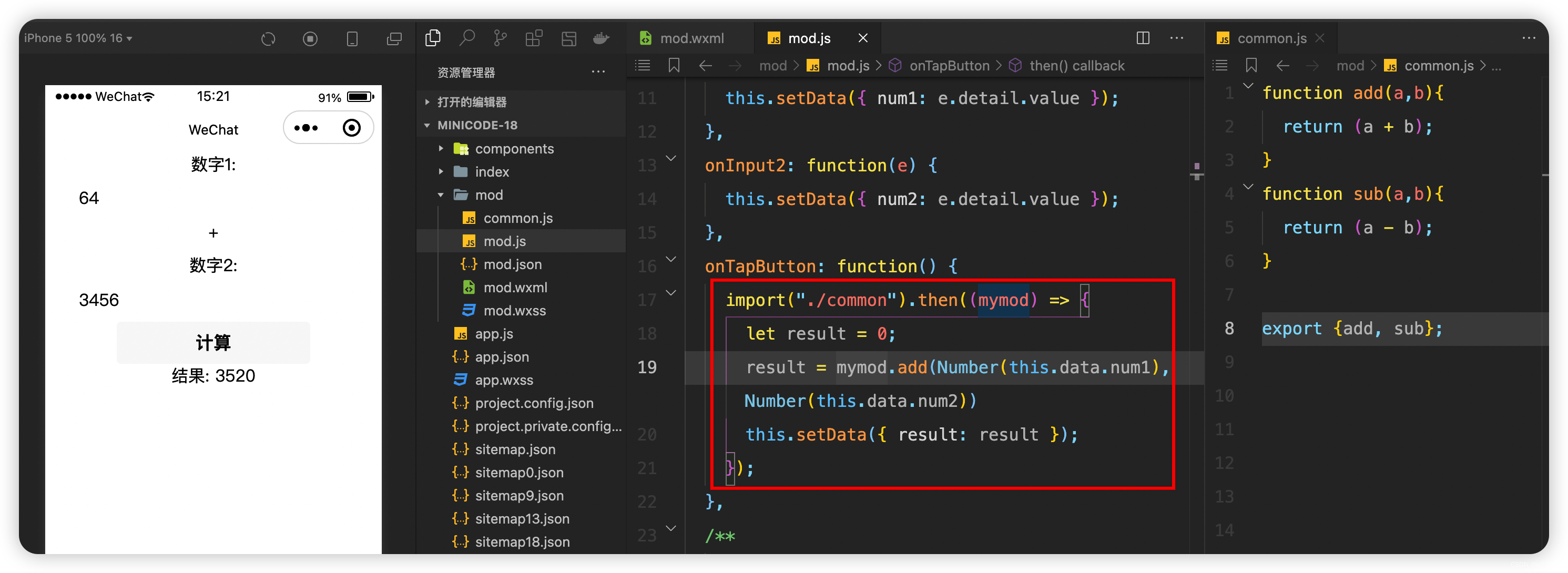微信小程序开发系列-14模块的导入与导出
微信小程序开发系列目录
文章目录
前言
对于初学者可能对CommonJS和ESmodules两种规范的导入导出的使用有点儿混淆,另外微信小程序官方文档写得只支持Common JS,一来是想理清两种导入导出方式,二来是想实际验证下微信小程序是否两种规范都支持。于是探索的过程便形成了此文。
什么是CommonJS
CommonJS是一种JavaScript语言的模块化规范,主要用于服务端的Node.js环境。每个文件在CommonJS中都被视为一个模块,具有独立的作用域、变量和方法,对其他模块不可见。模块通过module.exports暴露其公共接口,其他文件则通过require()方法来加载这个模块。CommonJS的主要目的是让各种模块能够在各个服务器环境中得到支持,并实现类似于本地文件模块系统一样的功能。CommonJS从原始设计上就是考虑到服务器端JavaScript,不适合客户端(这就是引入ES模块的原因)。
什么是ES modules
ES Modules(ESM)是ECMAScript的官方模块系统,也被称为ECMAScript Modules或简称ES Modules。它是JavaScript中用于模块化开发的新规范,也是ECMAScript 6(ES6)标准的一部分。
ES Modules引入了一种新的、官方的模块系统,以解决以前在JavaScript中模块化开发中存在的一些问题。它允许动态地导入和导出模块,提供了一种官方的模块化解决方案,促进了代码的模块化和复用。
与CommonJS等其他模块系统相比,ES Modules具有一些优势,例如静态导入和导出、静态模块结构、更好的异步支持、更强的类型检查等。主流的浏览器和Node.js环境都已支持ES Modules,开发者可以使用export和import语句来导入和导出模块,并在script标签中设置type="module"来使用模块内容。
ES modules
模块导出
在创建 JavaScript 模块时,export 语句用于从模块中导出实时绑定的函数、对象或原始值,以便其他程序可以通过 import语句使用它们。被导出的绑定值依然可以在本地进行修改。在使用 import 进行导入时,这些绑定值只能被导入模块所读取,但在 export 导出模块中对这些绑定值进行修改,所修改的值也会实时地更新。
存在两种 exports 导出方式:
- 命名导出(每个模块可包含任意数量)
- 默认导出(每个模块仅包含一个)
// 导出单个特性
export let name1, name2, …, nameN; // also var, const
export let name1 = …, name2 = …, …, nameN; // also var, const
export function FunctionName(){...}
export class ClassName {...}
// 导出列表
export { name1, name2, …, nameN };
// 重命名导出
export { variable1 as name1, variable2 as name2, …, nameN };
// 解构导出并重命名
export const { name1, name2: bar } = o;
// 默认导出
export default expression;
export default function (…) { … } // also class, function*
export default function name1(…) { … } // also class, function*
export { name1 as default, … };
// 导出模块合集
export * from …; // does not set the default export
export * as name1 from …; // Draft ECMAScript? 2O21
export { name1, name2, …, nameN } from …;
export { import1 as name1, import2 as name2, …, nameN } from …;
export { default } from …;
因此,对于ESModules 模块导出,是通过export语句来进行模块导出。
模块导入
静态 import 语句用于导入由另一个模块导出的绑定。
import statement
import defaultExport from "module-name";
import * as name from "module-name";
import { export1 } from "module-name";
import { export1 as alias1 } from "module-name";
import { default as alias } from "module-name";
import { export1, export2 } from "module-name";
import { export1, export2 as alias2, /* … */ } from "module-name";
import { "string name" as alias } from "module-name";
import defaultExport, { export1, /* … */ } from "module-name";
import defaultExport, * as name from "module-name";
import "module-name";
import()
The import() syntax, commonly called dynamic import, is a function-like expression that allows loading an ECMAScript module asynchronously and dynamically into a potentially non-module environment.
语法:
import(moduleName)
The import() call is a syntax that closely resembles a function call, but import itself is a keyword, not a function. You cannot alias it like const myImport = import, which will throw a SyntaxError.
标准用法的 import 导入的模块是静态的,会使所有被导入的模块,在加载时就被编译(无法做到按需编译,降低首页加载速度)。有些场景中,你可能希望根据条件导入模块或者按需导入模块,这时你可以使用动态导入代替静态导入。
下面的是可能会需要动态导入的场景:
- 当静态导入的模块很明显的降低了代码的加载速度且被使用的可能性很低,或者并不需要马上使用它。
- 当静态导入的模块很明显的占用了大量系统内存且被使用的可能性很低。
- 当被导入的模块,在加载时并不存在,需要异步获取。
- 当导入模块的说明符,需要动态构建。(静态导入只能使用静态说明符)
- 当被导入的模块有副作用(这里说的副作用,可以理解为模块中会直接运行的代码),这些副作用只有在触发了某些条件才被需要时。(原则上来说,模块不能有副作用,但是很多时候,你无法控制你所依赖的模块的内容)
import("/modules/my-module.js").then((module) => {
// Do something with the module.
});
学习完了理论,接下来,看看在微信小程序中,基于ESModules,进行导入导出的实验。
示例
本示例实现一个简单的加法运算,加法函数放在common.js中导出,然后在mod.js中导入并使用。
<!--mod/mod.wxml-->
<view class="container">
<view>数字1:</view>
<input type="number" placeholder="输入数字" bindinput="onInput1" />
<view>+</view>
<view>数字2:</view>
<input type="number" placeholder="输入数字" bindinput="onInput2" />
<button bindtap="onTapButton">计算</button>
<view>结果: {{result}}</view>
</view>
/* mod/mod.wxss */
.container {
display: flex;
flex-direction: column;
align-items: center;
}
input {
width: 80%;
margin-bottom: 10px;
}
button {
width: 80%;
}
view {
margin-bottom: 10px;
}
// common.js
function add(a,b){
return (a + b);
}
function sub(a,b){
return (a - b);
}
export {add, sub};
// mod/mod.js
import {add,sub} from './common'
Page({
data: {
num1: 0,
num2: 0,
result: 0,
},
onInput1: function(e) {
this.setData({ num1: e.detail.value });
},
onInput2: function(e) {
this.setData({ num2: e.detail.value });
},
onTapButton: function() {
let result = add(Number(this.data.num1), Number(this.data.num2));
this.setData({ result: result });
},
})

从上图的运行结果来看,导入导出是奏效的。接下来,再看看import()导入是否work。

Congratulations!动态导入也是奏效的。
CommonJS
CommonJS模块规范是Node.js中用于处理模块的标准。
模块导入
require(id)
id:<string> module name or path- Returns:<any> exported module content
Used to import modules, JSON, and local files. Modules can be imported from node_modules. Local modules and JSON files can be imported using a relative path (e.g. ./, ./foo, ./bar/baz, ../foo) that will be resolved against the directory named by __dirname (if defined) or the current working directory.
模块导出
Modules.exports 是一个对象 。
The module.exports object is created by the Module system. Sometimes this is not acceptable; many want their module to be an instance of some class. To do this, assign the desired export object to module.exports. Assigning the desired object to exports will simply rebind the local exports variable, which is probably not what is desired.
关于exports,它是一个变量,只是为了更简洁地书写而存在。module.exports.f = ...更简洁的书写成exports.f = ...,但是,请注意,与任何变量一样,如果将新值分配给 exports,则它不再绑定到 module.exports。一般不建议用这种。
The exports variable is available within a module’s file-level scope, and is assigned the value of module.exports before the module is evaluated.
下面一段伪代码可以很好地解释不建议使用exports的原因:
function require(/* ... */) {
const module = { exports: {} }; // default object
((module, exports) => {
// Module code here. In this example, define a function.
function someFunc() {};
exports = someFunc;
// At this point, exports is no longer a shortcut to module.exports, and
// this module will still export an empty default object.
module.exports = someFunc;
// At this point, the module will now export someFunc, instead of the
// default object.
})(module, module.exports);
return module.exports;
}
示例
这是示例的逻辑和上一节相同,只是将导入和导出用法改成了CommonJS的规范。

总结
通过本文的学习,掌握了在微信小程序中的模块的导入导出 既可以使用ES modules标准,也可以使用CommonJS标准。我个人更倾向于ES标准,模块的可移植性更好些。
本文来自互联网用户投稿,该文观点仅代表作者本人,不代表本站立场。本站仅提供信息存储空间服务,不拥有所有权,不承担相关法律责任。 如若内容造成侵权/违法违规/事实不符,请联系我的编程经验分享网邮箱:chenni525@qq.com进行投诉反馈,一经查实,立即删除!
- Python教程
- 深入理解 MySQL 中的 HAVING 关键字和聚合函数
- Qt之QChar编码(1)
- MyBatis入门基础篇
- 用Python脚本实现FFmpeg批量转换
- 【QT入门】基础知识
- antv/x6_2.0学习使用(二、画布)
- Go (一) 基础部分5 -- 单元测试,协程(goroutine),管道(channel)
- 详解 5 种注册中心,帮你轻松选型!
- Python+Pytest接口自动化之测试函数、测试类/测试方法的封装
- 敏捷四大价值观、十二项基本原则
- 2023年度总结:平淡而忙碌
- 计算机毕设ssm朱和涛线上花店系统eq0149【附源码】
- 提供一些防扫描被封禁、防溯源工具
- 【QT】QList<T>list 为例,移动赋值(Move Assignment)和拷贝赋值(Copy Assignment)